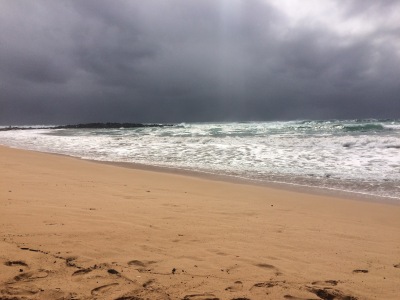Three signs have been posted at Niumalu Beach Park in Lihue warning of high bacteria levels in the water.
 The signs aren’t hailing beach closures, said Stewart Yamada, spokesman for Department of Health’s clean water branch. Their purpose is educational, and it means frequently the bacteria levels in the water surpass federal limits.
The signs aren’t hailing beach closures, said Stewart Yamada, spokesman for Department of Health’s clean water branch. Their purpose is educational, and it means frequently the bacteria levels in the water surpass federal limits.
“It’s to inform the public about areas of potential concern, so they can make informed decisions about the beaches where they choose to recreate,” Yamada said.
The signs posted Friday bring Kauai’s total of six contaminated water signs posted by the state’s DOH since August in cooperation with the Environmental Protection Agency.
“We continue to work with EPA to try and develop an acceptable plan to follow through on these kinds of areas and expand statewide,” Yamada said.
The request to post signage in areas where the bacteria count in the water frequently surpasses standards for recreational waters has been coming from the Kauai Chapter of the Surfrider Foundation, which monitors water quality on Kauai through their Blue Water Task Force.
For several years, the Blue Water Task Force has been recording high bacteria contamination at locations like Niumalu and Maha‘ulepu, where a similar sign was posted in August.
“It’s the responsibility of the state Department of Health to inform the public of health risks,” said Robert Zelkovsky, spokesman for Surfrider Kauai. “Bacterial pollution from human or other animal source in recreational waters is a public health hazard to both residents and visitors and they need to know.”
At Niumalu, one sign has been posted in front of Kaiola Canoe Club. Another has been posted by the boat ramp and a third was posted between the two kayak launch sites in the Nawiliwili Small Boat Harbor.
The signs at Niumalu could be temporary, but Yamada said DOH will be installing permanent signs in the area, and in places where tests show consistently high levels of bacteria contamination.
As resources are made available, Yamada said the DOH clean water branch staff will start to look into the source of the contaminations.
“I think you’re going to see (this) for the next month or so in the areas that are quite frequented,” Yamada said. “The greater focus will be on identifying the beaches and locations where there exists high bacteria.”
Even with exercising caution, Yamada said the clean water staff members will be “very busy” posting signs statewide.
“We owe it to the public to investigate,” Yamada said.
DOH is stepping up its signage game as a more conservative approach to protecting the residents and visitors of Hawaii, Yamada said.
“It’s important to understand in the past, the focus used to be on the evidence of human sewage,” Yamada said.
Those who have open wounds or sores, have compromised immune systems, and the children and the elderly are generally the most susceptible to infections resulting from contaminated water.
“If they do come into contact, shower off thoroughly and practice good hygiene,” Yamada said. “We can’t emphasize enough that everyone should avoid going into water with cuts and open wounds.”
Written for The Garden Island Newspaper, Published Sept. 13, 2016. Photo by Jessica Else.